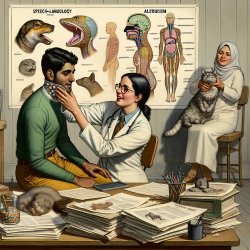Introduction
The study of heredity and genetics has long been a subject of fascination and debate, dating back to the 18th and 19th centuries. A pivotal historical investigation into this subject is captured in the research article titled "Mimush Sheep and the Spectre of Inbreeding: Historical Background for Festetics’s Organic and Genetic Laws Four Decades Before Mendel’s Experiments in Peas." This research provides a comprehensive look at early genetic theories and their implications, which can be surprisingly relevant to modern fields such as speech-language pathology.
Understanding Inbreeding and Heredity
The historical context provided by the article highlights the work of Imre Festetics, who explored the concept of inbreeding in sheep to enhance wool quality. His efforts predate Mendel's work on peas by four decades and laid the groundwork for understanding hereditary principles. Festetics's "laws of organic functions" and "genetic laws of nature" were early attempts to codify how traits are passed from one generation to the next.
While the primary focus was on animal breeding, the principles derived from these studies can be extrapolated to understand human hereditary traits, including those affecting speech and language development. The research underscores the importance of recognizing hereditary patterns, which can be crucial for speech-language pathologists working with children.
Implications for Speech-Language Pathology
Speech-language pathologists can draw valuable lessons from this historical research. Understanding the genetic basis of speech and language disorders is essential for developing effective therapeutic interventions. Here are some key takeaways:
- Early Identification: Recognizing hereditary patterns in speech and language disorders can lead to earlier identification and intervention, improving outcomes for children.
- Personalized Therapy: By understanding a child's genetic predispositions, therapists can tailor interventions to address specific needs, enhancing the effectiveness of therapy.
- Family Involvement: Engaging families in the therapeutic process is crucial, as hereditary factors may influence multiple family members. Educating families about genetic influences can foster a supportive environment for the child.
Encouraging Further Research
The historical exploration of inbreeding and genetics serves as a reminder of the importance of continuous research in understanding hereditary influences on speech and language development. Practitioners are encouraged to delve deeper into the genetic aspects of speech disorders, as this knowledge can lead to more effective interventions and better outcomes for children.
By integrating historical insights with modern research, speech-language pathologists can enhance their practice and contribute to the growing body of knowledge in the field. The intersection of genetics and speech therapy is a promising area for future research, with the potential to revolutionize how we approach speech and language disorders.
Conclusion
The historical research on inbreeding and genetics provides valuable insights that can be applied to modern speech-language pathology. By understanding the hereditary basis of speech and language disorders, practitioners can make data-driven decisions that lead to improved outcomes for children. To read the original research paper, please follow this link: Mimush Sheep and the Spectre of Inbreeding: Historical Background for Festetics’s Organic and Genetic Laws Four Decades Before Mendel’s Experiments in Peas.










